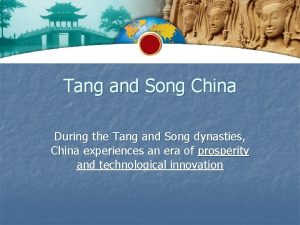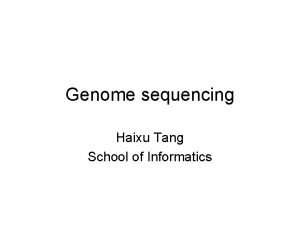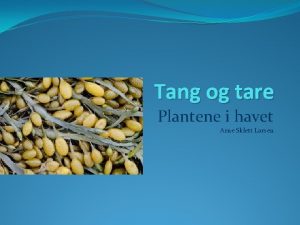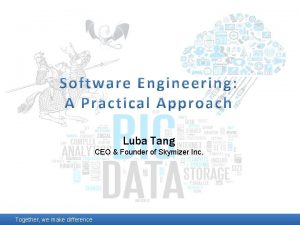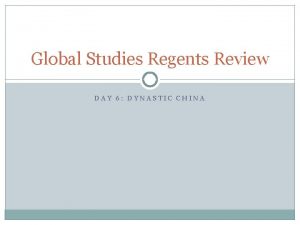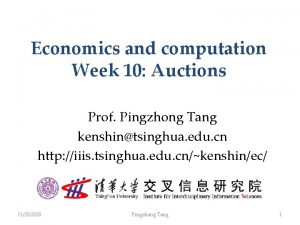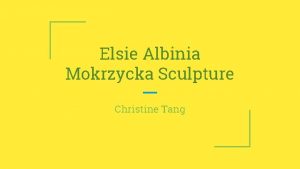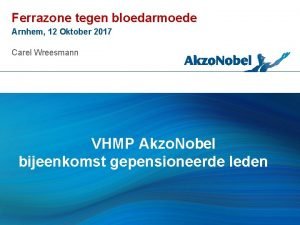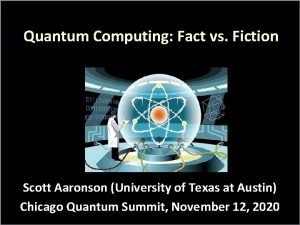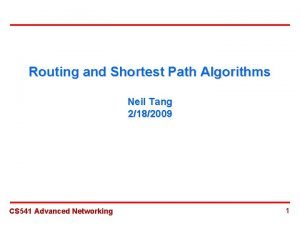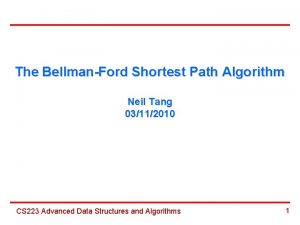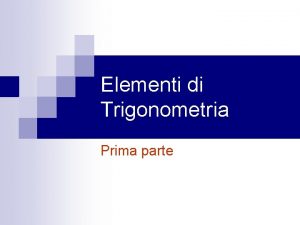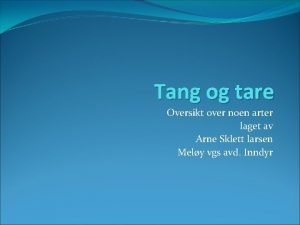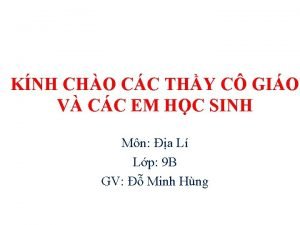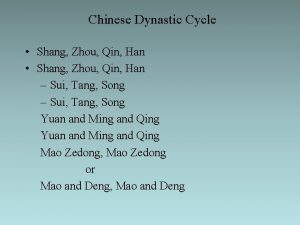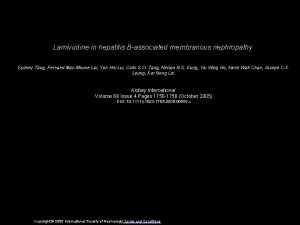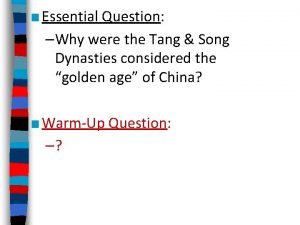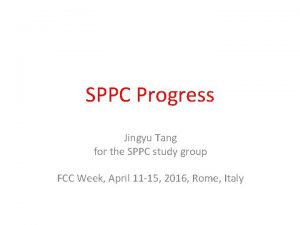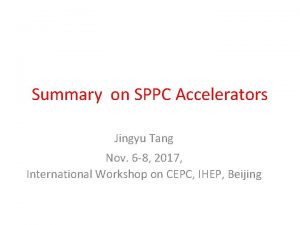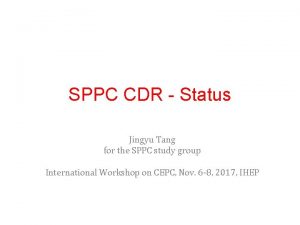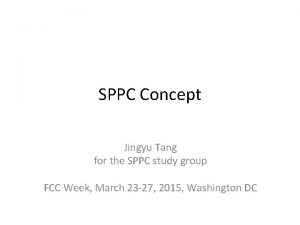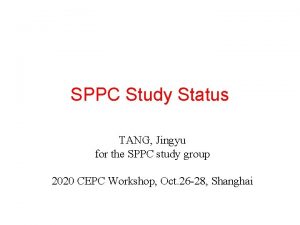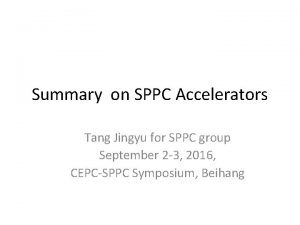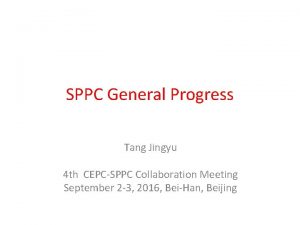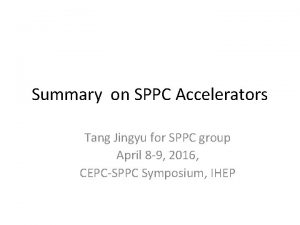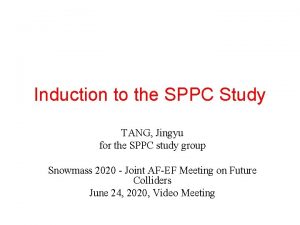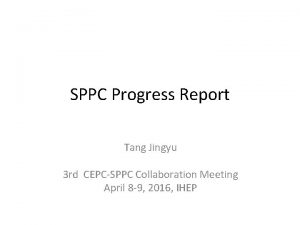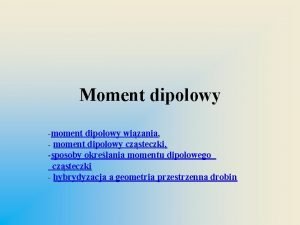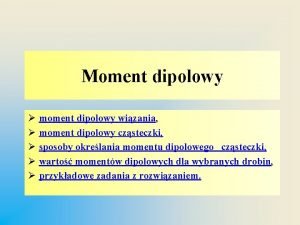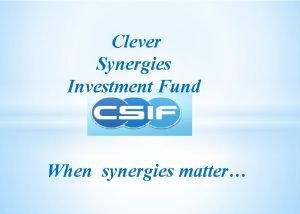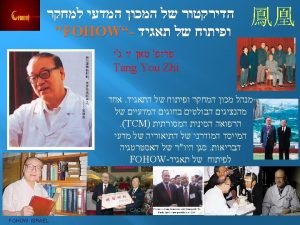MOMENT Synergies with Other Projects Jingyu Tang Institute

































- Slides: 33

MOMENT Synergies with Other Projects Jingyu Tang Institute of High Energy Physics, CAS Nu. Fact 2015, Rio de Janeiro, Brazil, Aug. 10 -15, 2015

Main Topics MOMENT concept Proton driver technology synergy with other projects Target technology synergy with other projects Neutrino beamline technology synergy with other projects • Detector technology synergy with other projects • Summary • •

MOMENT Concept

MOMENT Concept • MOMENT: A muon-decay medium baseline neutrino beam facility • MOMENT was launched in 2013 as the third phase of neutrino experiments in China – Neutrino experiments at Daya Bay continues data-taking – Jiangmen (JUNO, or DYB-II) has started civil construction • A dedicated machine to measure CP phase, if other experiments (such as LBNF/DUNE, Hyper. K) will have not completed the task • As a driving force to attract researchers from China as well international collaborators to work on neutrino experiments based on accelerators

A concept to exploit high-flux mediumenergy muon-decay neutrinos • Using a CW proton linac as the proton driver – Based on the China-ADS linac – 15 MW in beam power • Fluidized target in high-field SC solenoid – Granular tungsten or mercury jet – Collection of pions and muons of both charges • Neutrino beam from pure + or - decays – Medium energy (250 Me. V) for medium-baseline experiment – From long decay channel instead of decay rings for NF and nu. STORM

Decay channel - a 0 -free neutrino beam line • Neutrino energy: ~ 300 Me. V baseline = 150 km • Although we loose some statistics due to lower cross section, but we gain by being background free from 0

Schematic for MOMENT Detector Type to be defined

Proton driver technology synergy with other projects

MOMENT proton driver: a CW superconducting linac • A CW proton SC linac can provide the highest beam power, and selected as the proton driver for MOMENT • China-ADS project and MYRRHA are developing such a CW proton linac. PIP-II (PIXE) is developing CW RF linac but with lower beam duty. • If China-ADS program goes well, the linac could be also used as the proton driver for MOMENT in 2030’s. – Proton beam: 1. 5 Ge. V, 10 m. A (15 MW) – Alternate: extending energy to 2. 0 Ge. V

Design scheme for the C-ADS linac

R&D efforts on ADS linac at IHEP and IMP – IMP completed the commissioning test of a 5 Me. V front-end (10 m. A, 162. 5 MHz, 2. 1 Me. V RFQ in CW mode, a cryomodule HWR in pulsed mode) – IHEP is testing another scheme (3. 2 Me. V RFQ, a cryomodule Spoke, 10 m. A, 325 MHz) – Prototyping on both low- and medium- cavities

• High power proton accelerators are mandatory to neutrino beam facilities • MOMENT proton driver shares technologies with the other proposed neutrino beams, such as Neutrino Factory, Project-X (now PIP-II) and ESSnu. SB – Development of superconducting cavities (low- , medium- , high- ) and the high duty factor RF equipment – Beam loss control in high power proton linacs – Interface with target station Project-X (Upper) ESSnu. SB (Lower)

Neutrino Factory (SPL) Comparison of proton drivers Beam power (MW) Linac Energy (Ge. V) RF duty factor (%) MOMENT 15 1. 5 (~2. 5) 100 10 5 Neutrino Factory 4 5 (SPL) 4 20 2 Project-X (PIP-II) 3 (0. 2) 3 (0. 8) 100 (10) 5 (2) 6(5) 5 2 4 62. 5 3 ESSnu. SB (Project-X has also a pulsed linac section of 3 -8 Ge. V) Peak SC cavity current types (m. A)

Target technology synergy with other projects

MOMENT Target Station • Baseline design: Mercury jet target (similar to NF design, MERIT) and high-field superconducting solenoids – Higher beam power: heat load, radioactivity – On the other hand, easier to some extent due to CW proton beam (no shock-wave problem) • More interests in developing fluidized granular target in collaborating with C-ADS target team, and also waiting for study result with fluidized tungsten-powder target by NF collaboration Trying to work out a feasible concept based on granular target

High-field superconducting solenoids • Very large apertures due to collection of secondary /tertiary beams and space for inner shielding – Based on Nb 3 Sn superconducting conductors, CICC (Cable-in. Conduit Conductor) coil (ITER) – HTS coils are also under consideration – High-field magnet R&D efforts at IHEP (incorporated with SPPC)

• Different field levels have been studied: 7/10/14 T – Evident advantage on pion collection with higher field • Relatively short tapering section: <5 m (Vassilopoulos’ talk) • High radiation dose level is considered not a big issue here (compared with ITER case)(both Nb 3 Sn and HTS conductors are radiation resistant, problems are with electrical insulation)

Pion production and collection • Pion production rate: 0. 10 pion/proton (1. 5 Ge. V, 300 mm Hg) • Collection efficiencies of forward/total pions: 82% / 58% (@14 T) • Distributions in (X-X’)/(Y-Y’) at end of pion decay channel (from upper down: 7/10/14 T) • Higher field increases the core density significantly (favorable)

Spent protons See Cai’s talk • There are two parts in the spent protons: – Scattered protons from the side of the thin mercury jet and the pass-thru protons from the jet which have higher energy (4. 7 MW with 30 cm target) – From nuclear reactions, lower energy (1. 8 MW with 30 cm target) • We must find ways to deal with the spent protons, either collimated or separating from the / beam or transporting to the final dump. – Very difficult due to high beam power and large moment range and emittance

• High power target station is a technically challenging issue, and even more challenging when high magneticfield is required. – Huge heat deposit in target (cooling, shocking wave) – Very high irradiation level (protection, material lifetime, electrical insulation) – Very high electromagnetic force, space limitation – Interface with primary and secondary beamlines • Conventionally, carbon target inside a magnetic horn is used (very short pulse, up to 2 MW, low repetition rate) • New type of neutrino beams (NF and MOMENT) uses high-repetition or CW proton beams, and higher power – Mercury jet target (now preferable fluidized tungsten target) – Superconducting solenoids for capture and focusing – Extremely challenging

Synergy efforts • Precise simulations on production yield, material and proton energy – MARS, GEANT 4, MCNP, FLUKA: not consistent • Study on magnetic field taper • Design and R&D on fluidized tungsten target (NF and MOMENT) • Design and R&D on high-field superconducting solenoids (NF and MOMENT) • Study on cooling and shielding methods in MW targets • Interface issues with primary and secondary beamlines (windows, shielding, dump) • Spent protons

Comparison of target stations Beam power (MW) Proton energy (Ge. V) MOMENT 15 1. 5 (~2. 5) Granular W SC solenoids or Hg jet Neutrino Factory 4 5 (SPL) Fluidized W SC solenoids or Hg jet + RT insert LBNF 2 120 Carbon Horns ESSnu. SB 5 2 4 * Carbon Horns NF Target Station Target LBNF Target Station Magnetic field ESSnu. SB Target Station

Neutrino beamline technology synergy with other projects

MOMENT Secondary beamline • Transporting both pions and muons • A straight section in SC solenoids of about 100 m to match the SC solenoids at the target, and for the pions to decay into muons – – Adiabatic field transition (tapering section ) Extraction of scattered protons Very large emittance and momentum spread Longer section for energetic pions to decay • Similar beam rigidity assures that pions and muons can be transported in the same focusing channel – Momentum and emittance of pions most preserved in muons

More about the pion decay channel • SC solenoids form FOFO lattice (stop-band at certain energy) • Very large acceptance for channels • About 0. 0052 +/proton for about 50 mm-rad at entrance of muon decay channel 7 T muon/proton Portion(%) No limit on emittance 9. 48 E-03 100 Emittance: 100 πmm-rad 8. 04 E-03 85 Emittance: 80 πmm-rad Emittance: 50 πmm-rad 7. 31 E-03 5. 22 E-03 77 55 Emittance limit in both (X-X’) and (Y-Y’)

Charge selection • A selection section to select +/ + from -/ -, as either + beam or - beam is used for producing the required neutrinos – Reverse the fields when changing from + to – Also for removing very energetic pions who still survive – Very difficult due to extremely large beam emittance (T/L) • Two schemes: based on 3 SC dipoles with strong gradient (or FFAG), and bent SC solenoids

Muon transport and decay - Muon decay channel • A long decay channel of about 600 m is designed for production of neutrinos – About 35% (centered momentum: ~300 Me. V/c) • Important to have smaller divergent angle – Neutrino energy spectrum at detector related to the angle – Modest beam emittance and large aperture – Adiabatic matching from 3. 7 T in the bending section to 1. 0 T in the decay section Aperture/Field 600, 3. 7 T 800, 1. 0 T Acceptance ( mm-rad) X: in mm; X’: in mrad 100 (x: 280, x’: 357) 65 (x: 380, x’: 171)

Estimate of neutrino flux •

Challenges and synergy efforts in neutrino beamlines • Charge selection of +/ - and +/ - [NF] – Very large emittance/momentum range • Dumping both protons and secondary particles [All] – Mixed beam, high power • Manipulation in phase space [NF, nu. STORM] – Adiabatic conversion of transverse momentum into longitudinal – Bunching rotation – Emittance cooling

Detector technology synergy with other projects

• Suitable detectors for MOMENT are still under study – Flavor sensitive: e/ identification Water Cherenkov, liquid Ar, liquid scin. – Charge sensitive: and anti- Magnetized, liquid scin. , Gd-doped water (IBD) – NC/CC sensitive: NC background rejection – Very large target mass required • Detector synergy – Magnetized detector, e. g. MIND by NF and Super. BIND by nu. STORM – Water Cherenkov detector (or doped), MEMPHIS by ESSnu. SB/LBNO and Hyper. K detector – Liquid scintillator detector such as JUNO

Summary • As an interesting study, MOMENT attracts Chinese researchers to collaborate on neutrino beams – on MOMENT itself – on other international projects • MOMENT shares many physical and technical aspects with other neutrino beams – Proton driver, target, secondary beam line, detector etc. – International collaborations will benefit the community: with the ongoing projects LBNF and Hyper-K, and with the studies Neutrino Factory, ESSnu. SB and nu. STORM

Thank you for attention!
 Tang song china
Tang song china Self-initiated other-repair examples
Self-initiated other-repair examples Android tex
Android tex Cê sủi
Cê sủi Haixu tang
Haixu tang Sui tang song
Sui tang song Sui tang and song dynasties
Sui tang and song dynasties Tang dynasty map
Tang dynasty map Uu ee uu aa ting tang
Uu ee uu aa ting tang Vinh danh chúa ba ngôi trên các tầng trời
Vinh danh chúa ba ngôi trên các tầng trời Tangplante
Tangplante Luba tang
Luba tang Klep veer tang
Klep veer tang Xiao ke fang
Xiao ke fang How did the sui and tang dynasties reunite china
How did the sui and tang dynasties reunite china The map shows that on his voyages, zheng he explored
The map shows that on his voyages, zheng he explored 10auctions
10auctions What happened to tang
What happened to tang Biggs tang
Biggs tang Sui tang and song dynasties
Sui tang and song dynasties Nửa vòng trái đất rẽ tầng mây
Nửa vòng trái đất rẽ tầng mây Ferrostrane
Ferrostrane Neil tang
Neil tang Ewin tang
Ewin tang Shortest path
Shortest path Japan spice chart
Japan spice chart Color 03112010
Color 03112010 Archi associati tabella
Archi associati tabella Tang arter
Tang arter Cơ cấu dân số theo tuổi
Cơ cấu dân số theo tuổi Shang zhou qin han
Shang zhou qin han 618 song
618 song Sydney tang
Sydney tang The tang and song eras were a golden age of
The tang and song eras were a golden age of
